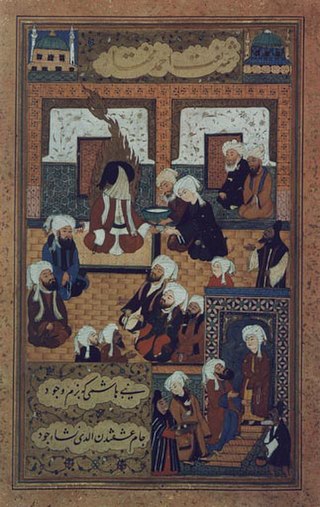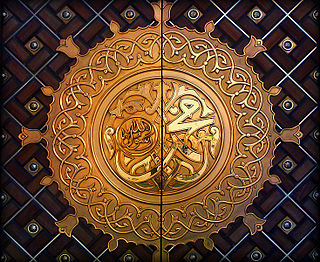
Abd Allah ibn Abi Quhafa, commonly known by the kunyaAbu Bakr, was the first caliph, ruling from 632 until his death in 634. A close companion and father-in-law of Muhammad, Abu Bakr is referred to with the honorific title al-Ṣiddīq by Sunni Muslims.

Muhammad was an Arab religious, social, and political leader and the founder of Islam. According to Islamic doctrine, he was a prophet divinely inspired to preach and confirm the monotheistic teachings of Adam, Abraham, Moses, Jesus, and other prophets. He is believed to be the Seal of the Prophets within Islam, with the Quran as well as his teachings and practices forming the basis for Islamic religious belief.

Mecca is the capital of Mecca Province in the Hejaz region of western Saudi Arabia and the holiest city according to Islam. It is 70 km (43 mi) inland from Jeddah on the Red Sea, in a narrow valley 277 m (909 ft) above sea level. Its metropolitan population in 2022 was 2.4 million, making it the third-most populated city in Saudi Arabia after Riyadh and Jeddah. Around 44.5% of the population are Saudi citizens and around 55.5% are Muslim foreigners from other countries. Pilgrims more than triple the population number every year during the Ḥajj pilgrimage, observed in the twelfth Hijri month of Dhūl-Ḥijjah. With over 10.8 million international visitors in 2023, Mecca was one of the ten most visited cities in the world.
The Nation of Islam (NOI) is a religious organization in the United States founded by Wallace Fard Muhammad in 1930. A black nationalist organization, the NOI focuses its attention on the African diaspora, especially on African Americans. While describing itself as Islamic, its religious tenets, though using Islamic terms, differ from orthodox Islamic traditions. Scholars of religion characterize it as a new religious movement. It operates as a centralized and hierarchical organization.

Sufism is a mystic body of religious practice found within Islam which is characterized by a focus on Islamic purification, spirituality, ritualism, and asceticism.

Medina, officially Al-Madinah al-Munawwarah and also commonly simplified as Madīnah or Madinah, is the capital of Medina Province in the Hejaz region of western Saudi Arabia. It is one of the oldest and most important places in Islamic history. One of the most sacred cities in Islam, the population as of 2022 is 1,411,599, making it the fourth-most populous city in the country. Around 58.5% of the population are Saudi citizens and 41.5% are foreigners. Located at the core of the Medina Province in the western reaches of the country, the city is distributed over 589 km2 (227 sq mi), of which 293 km2 (113 sq mi) constitutes the city's urban area, while the rest is occupied by the Hejaz Mountains, empty valleys, agricultural spaces and older dormant volcanoes.

Umar ibn al-Khattab, also spelled Omar, was the second Rashidun caliph, ruling from August 634, when he succeeded Abu Bakr as the second caliph, until his assassination in 644. Umar was a senior companion and father-in-law of the Islamic prophet Muhammad.

The Prophet's Mosque is the second mosque built by the Islamic prophet Muhammad in Medina, after that of Quba, as well as the second largest mosque and holiest site in Islam, after the Masjid al-Haram in Mecca, in the Saudi region of the Hejaz. The mosque is located at the heart of Medina, and is a major site of pilgrimage that falls under the purview of the Custodian of the Two Holy Mosques.

Ali ibn Abi Talib was the cousin and son-in-law of the Islamic prophet Muhammad, and was the fourth Rashidun caliph who ruled from 656 CE to 661, as well as the first Shia imam. Born to Abu Talib ibn Abd al-Muttalib and Fatima bint Asad, young Ali was raised by his elder cousin Muhammad and was among the first to accept his teachings.
The Battle of Badr, also referred to as The Day of the Criterion in the Qur'an and by Muslims, was fought on 13 March 624 CE, near the present-day city of Badr, Al Madinah Province in Saudi Arabia. Muhammad, commanding an army of his Sahaba, defeated an army of the Quraysh led by Amr ibn Hishām, better known among Muslims as Abu Jahl. The battle marked the beginning of the six-year war between Muhammad and his tribe. Prior to the battle, the Muslims and the Meccans had fought several smaller skirmishes in late 623 and early 624.

The Quraysh was an Arab tribe that inhabited and controlled Mecca and its Kaaba. Comprising 10 main clans, it included the Hashim clan, into which the Islamic prophet Muhammad was born. By 600 CE, the Quraysh had become wealthy merchants, dominating trade between the Indian Ocean, East Africa, and the Mediterranean. They ran caravans to Gaza and Damascus in summer, and Yemen in winter. They also mined and pursued other enterprises on these routes, placing business interests first and maintaining a measure of unity despite their rivalries.

The Companions of the Prophet were the disciples and followers of Muhammad who saw or met him during his lifetime, while being a Muslim and were physically in his presence.
The Hijrah, also Hegira, was the journey the Islamic prophet Muhammad and his followers took from Mecca to Medina. The year in which the Hijrah took place is also identified as the epoch of the Lunar Hijri and Solar Hijri calendars; its date equates to 16 July 622 in the Julian calendar.

The Alids are those who claim descent from Ali ibn Abi Talib, the fourth Rashidun caliph and the first imam in Shia Islam. Ali was also the cousin and son-in-law of the Islamic prophet Muhammad. The main branches are the Hasanids and Husaynids, named after Hasan and Husayn, the eldest sons of Ali from his marriage to Fatima, the daughter of Muhammad. As the progeny of Muhammad, they are revered by all Muslims. The Alids have led various movements in Islam, and a line of twelve Alids are the imams in Twelver Shia, the largest Shia branch.
A total of eleven women are confirmed as having been married to Muhammad, the founder of Islam. As a sign of respect, Muslims refer to each of these wives with the title Umm al-Muʼminin, which is derived from 33:6 of the Quran.

The military career of Muhammad, the Islamic prophet, encompasses several expeditions and battles throughout the Hejaz region in the western Arabian Peninsula which took place in the final ten years of his life, from 622 to 632. His primary campaign was against his own tribe in Mecca, the Quraysh. Muhammad proclaimed prophethood around 610 and later migrated to Medina after being persecuted by the Quraysh in 622. After several battles against the Quraysh, Muhammad conquered Mecca in 629, ending his campaign against the tribe.

In Islam, Muḥammad is venerated as the Seal of the Prophets and earthly manifestation of primordial divine light (Nūr), who transmitted the eternal word of God (Qur'ān) from the angel Gabriel (Jabrāʾīl) to humans and jinn. Muslims believe that the Quran, the central religious text of Islam, was revealed to Muhammad by God, and that Muhammad was sent to guide people to Islam, which is believed not to be a separate religion, but the unaltered original faith of mankind (fiṭrah), and believed to have been shared by previous prophets including Adam, Abraham, Moses, and Jesus. The religious, social, and political tenets that Muhammad established with the Quran became the foundation of Islam and the Muslim world.

The first Islamic State, also known as (city-)state of Medina was the first Islamic state established by Islamic prophet Muhammad in Medina in 622 CE under the Constitution of Medina. It represented the political unity of the Muslim Ummah (nation). After Muhammad's death, his companions known as the Rightly Guided Caliphs (Rashidun) founded the Rashidun Caliphate (632–661), which began massive expansion and motivated subsequent Islamic states, such as the Umayyad Caliphate (661–750) and Abbasid caliphate (750–1258).
It is believed that Jews began migrating to the Arabian Peninsula in as early as the 6th century BCE, when the Babylonian conquest of Judah triggered a mass Jewish exodus from Judea in the Land of Israel. Over time and through successive exiles, the local Jewish tribes, who were concentrated in the Hejaz and partly in South Arabia, established themselves as one of the most prominent ethno-religious communities of pre-Islamic Arabia. Likewise, Judaism, which had been introduced as one of the few monotheistic religions in the region, stood as a deviation from the typical polytheistic practices of Arabian paganism. These Jewish tribes continued to have a presence in Arabia during the rise of Muhammad, who founded Islam in the 7th century CE. Muhammad's interaction with the Jewish community is documented to a considerable degree in Islamic literature, including in many ahadith. The Jewish tribes of the Hejaz are seen in Islam as having been the offspring of the Israelites/Hebrews. Two of Muhammad's wives were Jewish: Safiyya bint Huyayy and Rayhanah bint Zayd, both of whom belonged to the Banu Nadir by birth, though Rayhanah's status as a wife is disputed.

The Kaaba, sometimes referred to as al-Ka'ba al-Musharrafa, is a stone building at the center of Islam's most important mosque and holiest site, the Masjid al-Haram in Mecca, Saudi Arabia. It is considered by Muslims to be the Bayt Allah and is the qibla for Muslims around the world. The current structure was built after the original building was damaged by fire during the siege of Mecca by Umayyads in 683 CE.













